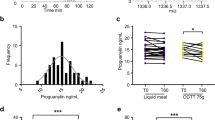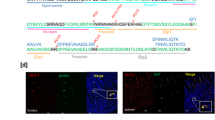Abstract
GASTRIN extracted from human intestine has two main molecular forms, little (G17) and big (G34) gastrins1. Both these peptides are also found in antral tissue although their relative proportions differ, G17 being the major component in antral tissue and G34 that in intestinal tissue1. The endocrine cell associated with the production of the immunoreactive gastrin found in the antral tissue is the ultrastructurally classified G cell2. The cellular origin of the immunoreactive gastrin extracted from the intestinal tissue has not been determined. The presence of cholecystokinin (CCK) peptides3,4, closely related to gastrin and sharing with it a C-terminal pentapeptide sequence (see Fig. 1), makes the specific immunological detection of both gastrin and CCK dependent on the use of well characterised and highly specific antibodies. We report here the finding that intestinal gastrin originates in a type of cell totally distinct from the I cell which has recently been identified as the source of CCK5.
This is a preview of subscription content, access via your institution
Access options
Subscribe to this journal
Receive 51 print issues and online access
$199.00 per year
only $3.90 per issue
Buy this article
- Purchase on Springer Link
- Instant access to full article PDF
Prices may be subject to local taxes which are calculated during checkout
Similar content being viewed by others
References
Walsh, J. H. Fedn. Proc. 36, 1948–1951 (1977).
Solcia, E., Vassallo, G. & Capella, C. in Origin, Chemistry, Physiology, and Pathophysiology of the Gastrointestinal Hormones (ed. Creutzfeldt, W.) 3–29 (Schattauer, Stuttgart, 1970).
Mutt, V. & Jorpes, E., Eur. J. Biochem. 6, 156–162 (1969).
Dockray, G. J. Nature, 270, 359–361 (1977).
Buchan, A. M. J. et al. Gut 19, 403–407 (1978).
Polak, J. M., Pearse, A. G. E. & Heath, C. M. Gut 16, 225–229 (1976).
Polak, J. M. et al. Experientia 33, 762–763 (1977).
Dockray, G. J. & Walsh, J. H. Gastroenterology 68, 222 (1975).
Dockray, G. J., Vaillant, C. & Hopkins, C. R. Nature 273, 770–772 (1978).
Coons, A. H., Leduc, E. H. & Connolly, J. M. J. exp. Med. 103, 49–60 (1955).
Baetens, D. et al. J. Cell Biol. 69, 455–464 (1976).
Lichtenberger, L. M., Lechago, J., Dockray, G. J. & Passaro, E. Gastroenterology 68, 1119–1126 (1975).
Solcia, E. et al. in Gut Hormones (ed. Bloom, S. R.) 40–48 (Churchill–Livingston, Edinburgh, 1978).
Author information
Authors and Affiliations
Rights and permissions
About this article
Cite this article
BUCHAN, A., POLAK, J., SOLCIA, E. et al. Localisation of intestinal gastrin in a distinct endocrine cell type. Nature 277, 138–140 (1979). https://doi.org/10.1038/277138a0
Received:
Accepted:
Published:
Issue Date:
DOI: https://doi.org/10.1038/277138a0
This article is cited by
-
Immunohistochemical Localization of Gastrin Cells (G-Cells) in the Alimentary Canal of a Skipper Frog, Euphlyctis cyanophlyctis, Schiedner, (Anura; Ranidae)
Proceedings of the Zoological Society (2015)
-
Histopathology, hormone products, and clinicopathological profile of endocrine tumors of the upper small intestine: A study of 44 cases
Endocrine Pathology (1991)
-
Xenopsin immunoreactivity in antral G-cells may reside in the N-terminus of gastrin 17
Histochemistry (1988)
-
Regulatory peptide immunocytochemistry at light- and electron microscopical levels
Experientia (1987)
-
Endorcine cells producing regulatory peptides
Experientia (1987)
Comments
By submitting a comment you agree to abide by our Terms and Community Guidelines. If you find something abusive or that does not comply with our terms or guidelines please flag it as inappropriate.



